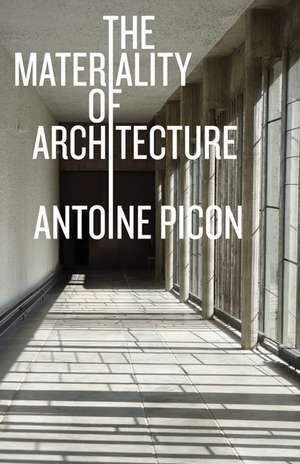The Materiality of Architecture
Autor Antoine Piconen Limba Engleză Paperback – 26 ian 2021
A new paradigm combining architectural tradition with emerging technologies
Digital tools have launched architecture into a dizzying new era, one in which wood, stone, metal, glass, and other traditional materials are augmented by pixels and code. In this ambitious exploration, an eminent thinker examines what, exactly, the building blocks of architecture have meant over the centuries and how technology may—or may not—be changing how we think about them.
Antoine Picon argues that materiality is not only about matter and that the silence and inscrutability—the otherness—of raw materials work against humanity’s need to live in a meaningful world. He describes how people define who they are, in part, through their specific physical experience of architectural materials and spaces. Indeed, Picon asserts, the entire paradox of the architectural discipline consists in its desire to render matter expressive to human beings. Through a retrospective review of canonical moments in Western European architecture, Picon offers an original perspective on the ways materiality has varied throughout centuries, demonstrating how experiences of the physical world have changed in relation to the evolution of human subjectivity.
Ultimately, Picon concludes that computer-based design methods are not an abrupt departure from previous architectural traditions but rather a new way for architects to control material resources. The result reinforces the fundamentally humanistic nature of architectural endeavor with an increasing sense of design freedom and a release from material constraint in the digital era.
Digital tools have launched architecture into a dizzying new era, one in which wood, stone, metal, glass, and other traditional materials are augmented by pixels and code. In this ambitious exploration, an eminent thinker examines what, exactly, the building blocks of architecture have meant over the centuries and how technology may—or may not—be changing how we think about them.
Antoine Picon argues that materiality is not only about matter and that the silence and inscrutability—the otherness—of raw materials work against humanity’s need to live in a meaningful world. He describes how people define who they are, in part, through their specific physical experience of architectural materials and spaces. Indeed, Picon asserts, the entire paradox of the architectural discipline consists in its desire to render matter expressive to human beings. Through a retrospective review of canonical moments in Western European architecture, Picon offers an original perspective on the ways materiality has varied throughout centuries, demonstrating how experiences of the physical world have changed in relation to the evolution of human subjectivity.
Ultimately, Picon concludes that computer-based design methods are not an abrupt departure from previous architectural traditions but rather a new way for architects to control material resources. The result reinforces the fundamentally humanistic nature of architectural endeavor with an increasing sense of design freedom and a release from material constraint in the digital era.
Preț: 177.18 lei
Nou
Puncte Express: 266
Preț estimativ în valută:
33.90€ • 36.25$ • 28.27£
33.90€ • 36.25$ • 28.27£
Carte disponibilă
Livrare economică 27 martie-10 aprilie
Livrare express 12-18 martie pentru 21.39 lei
Preluare comenzi: 021 569.72.76
Specificații
ISBN-13: 9781517909482
ISBN-10: 1517909481
Pagini: 192
Ilustrații: 36 B-W Illustrations
Dimensiuni: 140 x 216 x 20 mm
Greutate: 0.28 kg
Editura: University of Minnesota Press
Colecția Univ Of Minnesota Press
ISBN-10: 1517909481
Pagini: 192
Ilustrații: 36 B-W Illustrations
Dimensiuni: 140 x 216 x 20 mm
Greutate: 0.28 kg
Editura: University of Minnesota Press
Colecția Univ Of Minnesota Press
Notă biografică
Antoine Picon is G. Ware Travelstead Professor of the History of Architecture and Technology at Harvard University’s Graduate School of Design. He is chairman of the Fondation Le Corbusier and author of numerous books, including Ornament: The Politics of Architecture and Subjectivity; Digital Culture in Architecture: An Introduction for the Design Professions; and French Architects and Engineers in the Age of Enlightenment.
Recenzii
"Thanks to his immense knowledge of building technologies, along with the acute observations of contemporary practice made over the years, Antoine Picon has carved a masterful synthesis on the very substance of architecture. From ancient vestiges to current designs, the meaning of materials in designs and buildings is dissected in this dense, inspired volume. A must-read for students, scholars, and professionals alike."—Jean-Louis Cohen, author of The Future of Architecture Since 1889: A Worldwide History
"This rich and synthetic book rethinks four centuries of Western architectural discourse, arguing that materiality is not a raw essence, nor a state of being, but a branch of technological thinking. In six brisk chapters, Antoine Picon wonderfully combines lucid explanations of architects’ technical processes with insights on their cultural motives. The main takeaway—and it is a brilliant one—is that materials in architecture have ultimately served as a kind of linguistic referent. A needed corrective to recent claims of dematerialization, and a highly rewarding read."—Lucia Allais, author of Designs of Destruction: The Making of Monuments in the Twentieth Century
"This rich and synthetic book rethinks four centuries of Western architectural discourse, arguing that materiality is not a raw essence, nor a state of being, but a branch of technological thinking. In six brisk chapters, Antoine Picon wonderfully combines lucid explanations of architects’ technical processes with insights on their cultural motives. The main takeaway—and it is a brilliant one—is that materials in architecture have ultimately served as a kind of linguistic referent. A needed corrective to recent claims of dematerialization, and a highly rewarding read."—Lucia Allais, author of Designs of Destruction: The Making of Monuments in the Twentieth Century













